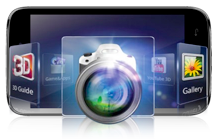
Micromax launches its first 3D smartphone A115 Canvas 3D for Rs 9,999

Homegrown handset manufacturer Micromax has further expanded its Canvas smartphone range with the launch of A115 Canvas 3D. As the name says, the device is the company's first 3D phone and you won't require glasses to view the content in 3D. This one will cost you just Rs 9,999 and will be available in all leading retail outlets of the country from the first week of May. You can also purchase it from the company's website.
Here is a look at the specifications.

The smartphone features a 5 inch touchscreen display (480×800 pixel resolution) with 16.7 million colours. It runs on the latest Android 4.1.2 Jelly Bean operating system and is powered by a 1 GHz MT6577 dual-core processor. The device comes with 512 MB RAM and 4 GB of internal memory, which can be expanded up to 32 GB with the help of a microSD card.
On the camera front, it has a 5 megapixel rear camera that can record videos at 30 frames per second and a 0.3 MP front-facing camera for video calling. The smartphone also enables users to convert regular pictures into 3D ones.
As for connectivity front, it has Bluetooth 4.0, Wi-Fi and 3G, as well as a microSD slot. Size and weight are not available yet, but it comes with GPS. Micromax has provided a 2,000 mAh battery in the device, which it claims will provide 4.5 hours of battery life and 225 hours of standby time.

Here is a video introducing the smartphone.
The smartphone also comes bundled with Micromax 3D Space that provides access to 3D videos and pre-loaded 3D games (after all, what use is a smartphone with a 3D screen if you don't have 3D content to watch/play). At Rs 9,999, it is priced right, but whether that will be enough to woo the buyers is a different matter altogether.

Recently, Micromax disclosed it had sold more than 1 million Canvas smartphones. Although building on a successful series is an intelligent move ahead, Micromax should not have high hopes regarding its latest offering. Large companies like LG and HTC already tried their luck with 3D smartphones in the past, but had little success. This is because the 3D element is not a game-changer when it comes to smartphones (else Apple would have already done it and Samsung would have followed without delay). Some users also complain that they become disoriented after using a 3D smartphone for a while and that can be another minus for this new device.
(Edited by Sanghamitra Mandal)

